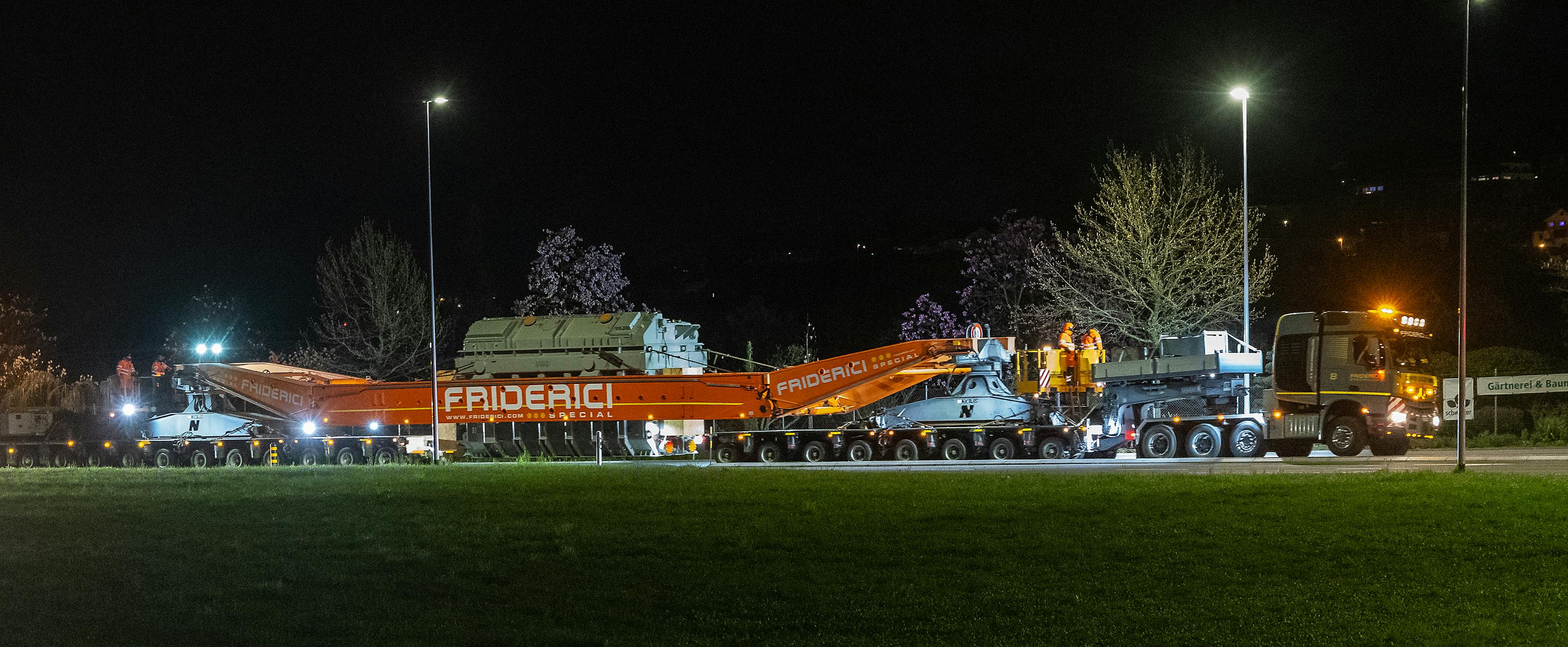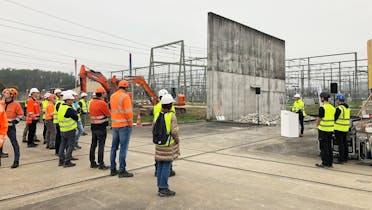Grid project

A great deal has happened since the groundbreaking ceremony for the new transformer at the Mettlen substation in October 2022. The modernisation of this important node in the Swiss transmission grid is progressing according to plan. It is time to take a look at the construction milestones so far.
Innovative planning with foresight
The pre-project and construction project phases established the basis for the successful implementation of the project. Over a period of around 16 months, a team drew up detailed plans, issued invitations to tender, obtained approvals, took safety precautions and set up the construction site. This phase was crucial to ensure the smooth running of the construction work.
Between concrete and screen
20 October 2022 was a key date: the groundbreaking ceremony took place to mark the start of construction work. In the first stage of the project, the existing foundation of the reserve pole was removed to create sufficient space for the new transformer stands. By the end of October 2023, just one year later, the seven transformer foundations had already been built. Specialists used around 9,000 tonnes of concrete. A significant proportion of the concrete required for the work at the Mettlen substation, i.e. around 18 percent, is recycled concrete.
The «BIM-to-Field» method was used for coordination between the engineering specialists and the workers on the construction site. BIM-to-Field refers to a sub-process within the construction project. The planning data is transferred from a virtual model to the construction site so that it can be applied in practice. This also improves accuracy: if there are any changes, they are rapidly integrated into the virtual model and the update is available directly on the construction site – without having to draw, print and distribute a new plan to all the relevant parties.
A 200-tonne Easter present
The phase-shifting transformer was the first new part to be delivered; it arrived during Easter week. This is for controlling the load flow in the grid. On the night of 26 to 27 March 2024, the first heavy goods vehicle made its way from Auhafen Basel via Staffelegg, past Lenzburg and onwards via Muri to the Mettlen substation. It was carrying one of the three poles of the first main transformer on its trailer. The other two poles are due to arrive at the Mettlen substation by the end of May. It can then be put into operation. This is essential before the existing transformer can be disconnected from the grid and dismantled. The dismantling of the «old» transformer bays will then create space for the installation of the second main transformer, which will be delivered in 2026. If everything continues according to plan, the new transformer will be ready for operation and the project will be completed by the end of 2026.
For people and the environment
People need more and more electricity, and require it to be reliably available – wherever and whenever they want it. This also necessitates a stable grid. And, of course, transformers that enable electricity to flow between the different grid levels. However, major infrastructure projects, such as the one at the Mettlen substation, always have an impact on the environment. In the course of this project, Swissgrid has taken various measures to ensure that the greatest possible care is taken:
| Recycled concrete | Around 18 percent of the concrete used in the project is recycled concrete. As the name suggests, this is concrete made from recycled materials, in particular from used concrete rubble. This helps to improve sustainability in the construction industry and to reduce the ecological footprint of construction projects. It has a range of different advantages:
|
| Further use | The 600-MVA transformer which has been in use at the Mettlen substation for around 20 years and is now being replaced, is not yet obsolete. Following an overhaul, it will be temporarily stored before being deployed at a new location in the Swiss transmission grid at a later date. |
| Flood protection | As part of the modernisation project, the site has been protected against flooding. This is a risk due to its position close to various watercourses. |
| A home for small animals | The banks of the Winkelbach stream, which runs directly across the substation site, as well as the adjoining hedgerows and copses, provide a home for many small animals. To ensure that the site remains accessible to them, Swissgrid is placing particular emphasis on incorporating native and near-natural small structures into the design phase. Small ramps made of heaped-up stones will be installed, for instance. These will serve as bridges and hiding places for weasels, amphibians and reptiles without causing water to accumulate in the Winkelbach. |
The new heart of the Mettlen substation
The Mettlen substation is one of the most important parts of Switzerland’s transmission grid. Swissgrid’s transmission system comprises 125 substations, housing 147 switchgears and 26 transformers. Transformers are the beating hearts of the substations. They are used to increase or reduce the voltage of the electrical energy or the current, and they connect the 380-kilovolt grid to the 220-kilovolt grid. A 380/220-kV transformer system with a 600-MVA transformer and a reserve pole is currently installed in the Mettlen substation. This transformer will be replaced by two new 380/220-kV transformers, each with a throughput of 800 MVA and each with three single-phase transformers. This will more than double the transformer capacity from 380 to 220 kilovolts. The new transformer system will also include a reserve pole that can be used for both transformers. The total project costs amount to CHF 70 million. The contract for the engineering, fabrication, delivery and installation of the transformers was put out to public tender, and the contract was awarded to Siemens Energy. Engineering was completed in autumn 2022, after which the first transformers went into production at the Siemens Energy plant in Weiz, Austria.
Would you like to know more about how a substation works? An illustrated guide can be found here.













